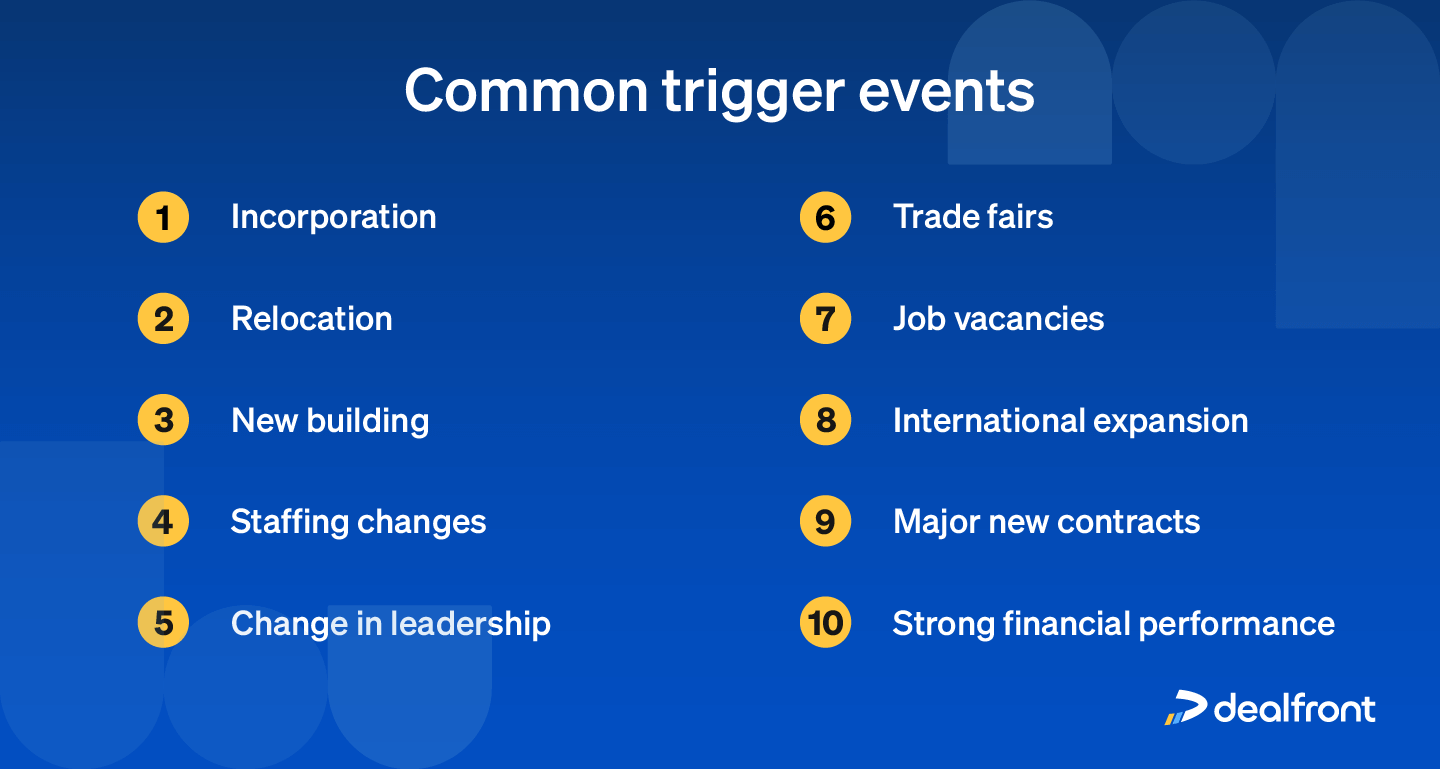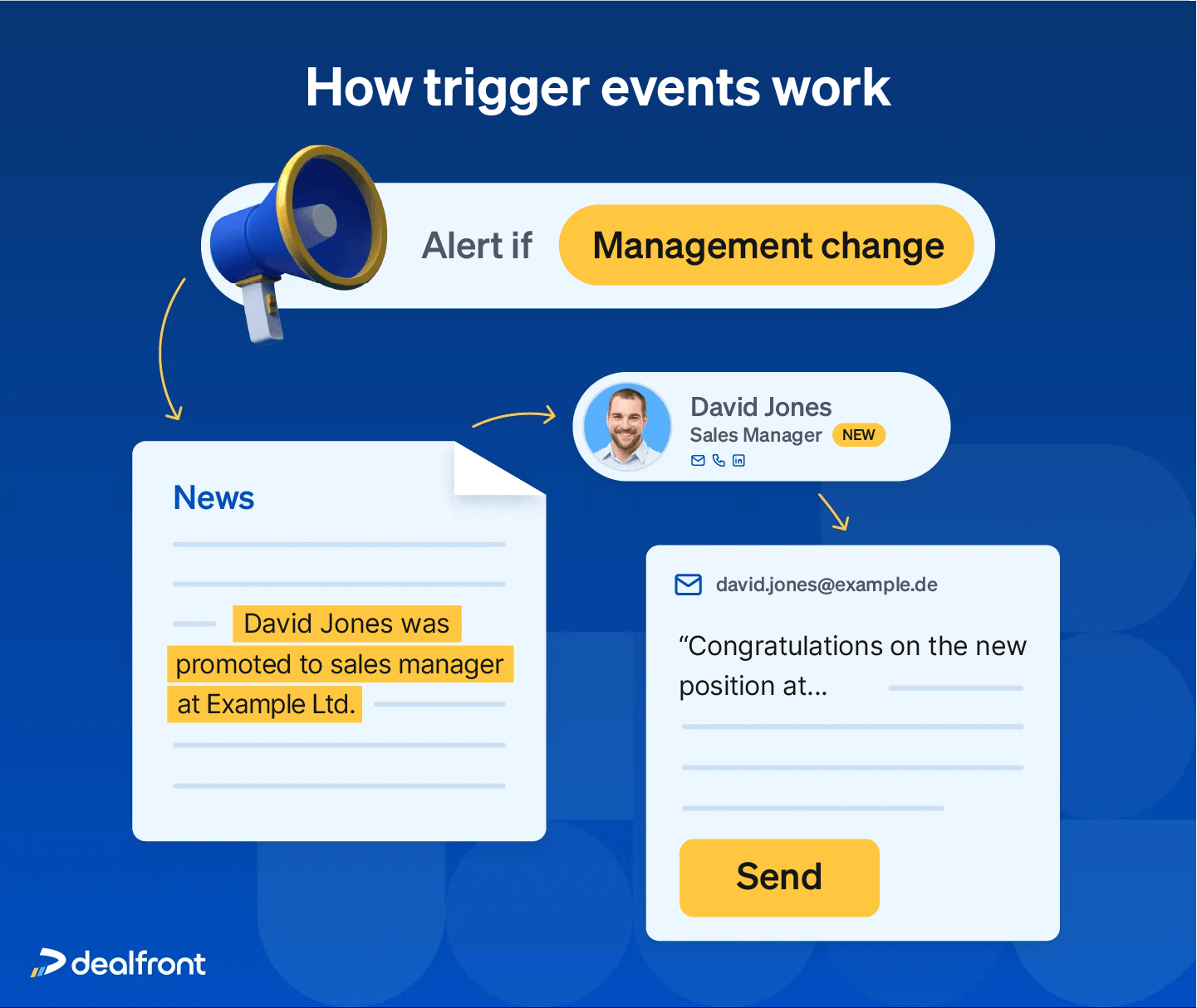60-Second Summary
Sales strategies are evolving, and trigger events are at the core of this transformation. These real-time signals help sales professionals better time their outreach, personalize conversations, and discover untapped opportunities within their market or competitive landscape.
Trigger events unlock strategic outreach moments: From office expansions to leadership changes, these insights reveal when buyers are most receptive to personalized engagement.
Sales intelligence drives relevance and timing: By monitoring over 30 trigger types such as funding events, job listings, or trade fair participation via tools like Dealfront, reps can match offerings to real-time company needs.
Turn periods of change into opportunity: Events like layoffs, mergers, or expansion often lead to shifts in priorities—creating perfect openings to offer cost-saving or scaling solutions.
Trigger-based outreach builds trust: Reaching out based on relevant business events shows empathy and insight, leading to better engagement, shorter sales cycles, and stronger customer relationships.
For sales people, these triggers offer the very first insights into a change in a business' situation and can mean opportunities to upsell, land new business, or bring on fresh customers. These real-time triggers are also a great way for companies to keep tabs on their competitors and for spotting trends in your market.
The problem in sales
The problem with sales is that, at its core, it hasn’t changed much in decades. Despite all the shifts in business and technology, sales has traditionally been slow to adapt, leaving the process inefficient and time-consuming. Reps still spend too much time chasing the wrong leads, relying on outdated strategies, and struggling to connect at the right moment. But that’s finally starting to change. New technologies are stepping in to streamline the process, offering smarter ways to find sales opportunities, understand prospects, and close deals faster.
One of the biggest challenges in sales has always been finding out the right time to reach out to a prospect. That’s where event triggers come in. By staying on top of what’s happening in your market, your industry news, or even with specific companies, you can time your outreach perfectly. These insights let you make smarter calls and have meaningful conversations with companies and the most opportune moments.
"Trigger events are game-changers for any sales rep. They let you craft personalized, perfectly timed outreach that stands out. Plus, they're just as powerful for prepping when a lead comes inbound. It’s all about combining timing and relevance to win deals."
Marvin Karis, Senior Director GTM Execution at Dealfront
Types of trigger events
But trigger events are also essential for improving your outreach timing too. These insights provide the opportunity to stay ahead of your competition. At Dealfront, we track 30+ unique types of trigger, meaning you can have a whole range of Sales Intelligence insights delivered to you to help make your outreach more effective.
Here’s a list of the event triggers we track at Dealfront, plus a quick look at the insights they can give you:
Construction projects
Construction plans: This trigger event indicates a company’s construction plans signals upcoming growth, investment, and resource allocation. This could involve building new offices, warehouses, factories, or data centers, each reflecting specific strategic priorities. For a salesperson, this is a chance to align offerings with the company’s needs during a critical planning stage and reaching out now will put you at the best chance of having your solution seriously considered.
For example, new office construction might mean opportunities for workspace solutions, IT infrastructure, or HR systems. A new warehouse could indicate a need for logistics, supply chain, or security technologies. Data center construction highlights demand for advanced storage systems, cybersecurity, and energy-efficient solutions.
New buildings and expansions: A new office or building expansion is a common trigger and a major signal of growth and investment, often highlighting key business priorities. Depending on the type of new building or expansion announced, this could mean different things for each organization respectively.
For example, a new headquarters suggests company-wide scaling and the need for enhanced HR and operational solutions. Similarly, office expansions into new regions point to market growth and local workforce setup, while new branches (common in finance and law), focus on improving customer service and client acquisition. Different again are R&D or tech hubs that drive product development and require solutions fostering innovation, and data centers which focus on IT infrastructure and demand robust security and storage capabilities. Each type of expansion offers unique opportunities to align with a company’s evolving needs.
Start of construction phase: This trigger signals that a company’s plans are moving forward and entering the execution phase. This stage reflects committed investment and immediate needs for resources, services, and solutions to support the project.
This offers a key opportunity to target areas where the company may require assistance during the construction phase. For example, new office builds might need office equipment, IT setup, or furniture solutions. Warehouse or factory projects may require supply chain systems, machinery, or safety equipment. Data center builds will likely need specialized infrastructure, cooling systems, and robust cybersecurity. Engaging at this stage allows you to offer timely, relevant solutions while the company is actively making purchasing decisions.
Events
Awards: A company being nominated for, or receiving, an award is a fantastic conversation starter! Awards can reveal a company’s strengths, highlight potential weaknesses, or show where they stand in the market. These insights can even be used by competitors to spot areas where they need to step up (or keep up), improve their offerings, or capitalize on market gaps.
Lottery game: This event refers to promotional campaigns or contests where companies offer prizes or incentives, often tied to customer engagement or product purchases. This kind of campaign can provide great insights into a company's marketing strategy and its focus on customer acquisition or retention. A lottery game is an opportunity to identify companies ramping up their promotional efforts, which might indicate they’re looking for new tools or services to support these initiatives. It’s also a great opening for a sales rep to discuss how your product or service can help enhance customer engagement or streamline the execution of similar campaigns. Essentially, it shows a company’s focus on boosting visibility and sales, making it a perfect time to offer a relevant solution.
Trade fair attendance: When a company announces their attendance at a trade fair, it’s a golden opportunity to spark a conversation. These updates can reveal what the company is focused on, highlight any new developments they’re showcasing, and even point you toward key decision-makers who’ll be attending. It’s also a great way to get a glimpse into their future direction and priorities, which will also make life easier for you when you come to tailoring your outreach.
Expansion
Expansion abroad: When a company announces plans to expand into new regions or geographies, it’s a strong signal that they’re in growth mode and likely to need new tools and services to support their ambitions. International expansion often brings unique challenges, like adapting to new markets, managing diverse teams, and scaling operations. In turn, this can create demand for solutions like sales enablement software, HR systems, marketing automation, and data enrichment platforms. These companies are actively preparing to tackle fresh opportunities and pain points, making this the perfect time to reach out with tailored offerings that can support their success in new territories.
Mergers & acquisitions: Mergers and acquisitions (M&A) signal significant change within a company, and these changes often create new opportunities for sales teams. When one company acquires another, it typically leads to shifts in hiring, funding, and operations. This can open the door to adopting new technologies, systems, and strategies across the organization. For sales, this is an important moment to engage, especially if one of the companies involved is already a customer.
Acquiring a company often means the acquiring business is focusing on expanding its offerings, whether by launching new products or entering new markets. This can be a great opportunity for upselling or cross-selling, as the company may be looking to integrate new tools, products, or services. If the acquisition involves a physical facility, it could also indicate the need for updated management systems to support an expanded workforce or new business operations. Similarly, if the acquisition involves a product, it could lead to increased investment in that product, creating potential for growth in areas like sales, marketing, or production.
"When a company undergoes a merger or acquisition, it's not just business as usual, it’s a signal for transformation. This is the perfect time to step in with solutions that can support their growth, streamline operations, or integrate new systems. Timing is everything."
Marvin Karis, Senior Director GTM Execution at Dealfront
Financial decline
Cost-cutting measures: When a company announces a cost-cutting initiative, it suggests that they’re looking to reduce overall spending. However, this doesn’t necessarily mean they’re cutting spending altogether. Instead, they might be seeking a more cost-effective solution, such as consolidating multiple services into one, or they could be looking for cheaper alternatives to what they’re currently using. This presents an opportunity for sales, as companies often remain open to solutions that can help them save money while still meeting their needs.
Financial losses: A company announcing financial losses is a key trigger event to watch for. When a business reports a drop in profits or financial struggles, it's a clear sign they may be reassessing their resources and strategies. This creates an opportunity for sales teams to step in and offer solutions that can help address their challenges. Often, companies facing monetary losses are looking for ways to improve efficiency, cut costs, or drive growth, and your solution could be just what they need to turn things around. It’s an ideal time to reach out and position your solution as part of their recovery plan.
"Financial losses might seem like a red flag, but for a salesperson, they’re a green light for opportunity. Businesses looking to cut costs or boost efficiency are primed for solutions that can help them turn things around. This trigger allows you to be the partner they need right now!"
Marvin Karis, Senior Director GTM Execution at Dealfront
Reduction in earnings: A company reporting a reduction in earnings often indicates financial challenges or shifts in priorities. This can signal an opportunity to offer cost-effective solutions that help the company cut expenses, streamline operations, or improve efficiency. Businesses facing reduced earnings are typically looking to stabilize and recover, making this a great time to present products or services that deliver measurable value and a strong return on investment.
Reduction in revenue: A drop in revenue can be another clear sign that a company is experiencing market pressure, operational inefficiencies, or declining demand. For sales teams, this market trigger highlights a potential need for strategies or tools that can drive new business, optimize processes, or enhance sales performance. Companies in this position are often open to innovative solutions that can help them turn things around and regain momentum. This is your chance to demonstrate how your offering can address their challenges and support their recovery.
Financial growth
Financing / Equity increase: When a company announces a funding round or equity increase, it typically signals a major boost to its resources, which can lead to significant growth and expansion. This influx of capital allows the business to scale its operations, whether that’s hiring more staff, investing in new software or technology, or improving overall performance and capabilities.
Whether through venture capital, debt financing, or crowdfunding, the additional funds provide the company with the means to accelerate its plans. With fresh financing, companies are often poised to invest in areas that will enhance their competitive position, making them prime targets for partnerships, investments, or business solutions that can help them meet their new objectives.
Increase in earnings: When a company reports an increase in earnings, it’s often a sign of financial health and stability. With higher profits, businesses may be more willing to invest in new tools, technologies, or services that can help them sustain or accelerate their success. This is the perfect moment to position your offering as a way to capitalize on their momentum, improve efficiencies, or explore new growth opportunities.
Increase in revenue: An increase in revenue suggests that a company is growing and generating more income from its operations. This often means they’re scaling their efforts, entering new markets, or expanding their customer base; activities that can create new needs for tools, services, or support. This is a chance to align with their growth strategy and offer solutions that help them manage or amplify their upward trajectory.
Job offers / job ads
Job offers on job portals: When companies post job listings on job portals like Indeed or Glassdoor, it’s a clear indicator that they’re growing or filling key positions. This expansion often means they’ll need additional tools, services, or support to manage increased workloads and help new hires succeed. For sales professionals, this is the perfect time to approach with solutions that can streamline operations, enhance employee onboarding, or support business growth as they bring fresh talent on board.
Job offers on social media: Job ads on platforms like LinkedIn or Facebook signal that a company is actively seeking talent and investing in their growth. These listings often suggest a forward-thinking approach, as companies leverage social media to attract candidates and build their employer brand. For sales teams, this is an opportunity to connect with businesses looking for innovative solutions to support recruitment efforts, improve productivity, or enable the success of their expanding teams.
Job offers on website: Job postings on a company’s own career page are a direct sign that they’re hiring and potentially scaling up. Companies using this channel are often in control of their recruitment strategy and may be seeking cost-effective or tailored solutions to meet their growing needs. This is an excellent time for sales professionals to engage with offers that can support their recruitment goals, streamline workflows, or enhance efficiency as they onboard and grow their teams
Negative events
Bankruptcy notice: When a company files for bankruptcy, it often marks a significant turning point that can reveal both challenges and opportunities for sales reps. While bankruptcy signals financial distress for an organization, it can also indicate a need for restructuring, new leadership, or a shift in business strategy. For sales professionals, this event offers valuable insights into potential changes in the company's operations, such as cost-cutting measures, the adoption of new technologies, or the need for fresh solutions to help the company recover.
A bankruptcy filing may open doors for offering services that help streamline operations, reduce overhead, or support a company’s recovery efforts. It’s a situation where a sales rep’s ability to provide practical, cost-effective solutions can make a real difference in helping the company get back on track.
Lawsuit: When a company is facing legal proceedings, it needs to act quickly to tighten up its procedures to ensure compliance with all relevant laws and data privacy regulations. The first impact of this trigger is likely to be a tarnished reputation, so reassuring clients, investors, and other stakeholders will be a top priority. If the company decides to pursue legal action, it could be for various reasons, such as protecting intellectual property or preventing the infringement of its products. In this case, the company might spend significantly on legal defense and protection against future similar claims.
If the company settles the legal dispute, it can help them avoid expensive court fees and reduce risk compared to going to trial. On the other hand, if the company loses the legal battle, the cost isn’t just financial; it can also cause significant damage to the company’s reputation and brand. Recovering from this will involve a concerted effort focused on compliance, rebuilding trust with customers, and repairing relationships.
"When legal challenges hit, companies often need to tighten compliance, rebuild trust, and streamline their processes. That creates a golden opportunity for you to offer tools and strategies that help them recover faster and operate more securely."
Marvin Karis, Senior Director GTM Execution at Dealfront
Product recall: A product recall occurs when a company identifies a safety issue or defect in one of its products and takes steps to remove it from the market. These announcements are often focused on protecting customers and maintaining trust, but they can also signal significant activity within the business. Companies may invest in improved safety measures, enhanced testing protocols, and increased spending on marketing and customer service as part of their efforts to manage the situation and protect their reputation. For sales professionals, these events can indicate opportunities as businesses may look for solutions to prevent future issues or improve their processes.
Site closure: A site closure announcement signals a significant change for a company, often tied to cost-cutting, restructuring, or shifting business priorities. For sales reps, this can uncover opportunities to offer solutions that help the company navigate the transition, whether that’s optimizing operations, supporting displaced teams, or addressing new challenges created by the closure.
It can also be a chance to engage with former employees who may move to other companies, bringing fresh opportunities for connection. Understanding the reasons behind a site closure and the ripple effects it creates allows sales reps to approach the situation thoughtfully and position their offering as a valuable resource during a time of change.
Strike: A strike within a company or industry is a powerful signal for sales reps to pay attention to. Strikes often indicate significant internal issues, such as employee dissatisfaction, disputes over pay, or operational inefficiencies. This can create the perfect opportunity for you to step in with solutions that address the underlying challenges. Whether it’s tools to improve communication, streamline operations, or boost employee engagement, a strike highlights a clear pain point that your product or service might help resolve. Monitoring these events allows you to approach the company with informed, timely suggestions that show you understand their current struggles.
Personnel change
Change of management: Changes in a company’s management team are a strong indicator of potential shifts in strategy, priorities, and opportunities. When senior roles are filled by new hires, promotions, or reshuffled leadership, it often signals an openness to fresh ideas and solutions to support these changes. This can mean you have a fresh chance to connect with decision-makers who may be evaluating new initiatives or looking to make an impact in their roles. Whether it’s a key executive moving to a different company, a new board member bringing a strategic focus, or a retiring leader creating space for fresh leadership, each change offers valuable insights into the company’s direction and potential needs.
Staff cuts: Job cuts, while unfortunate for all affected, can signal significant shifts within a company. When a business announces layoffs, it’s often a sign that they are undergoing cost-cutting measures or restructuring. However, these changes typically create an increased need for solutions that drive efficiency, streamline operations, and deliver better results with fewer resources. This can open up opportunities to offer services or products that help the company navigate these challenges and maximize their remaining assets.
Team expansion: When a company announces team growth through senior appointments, it’s a strong indicator of upcoming change and opportunity. These hires often represent decision-makers or team leaders who are stepping into roles with the goal of making an impact. New leaders typically look to establish their own strategies, processes, and solutions to drive success within their teams or the company as a whole. For sales professionals, this provides not only a clear contact to reach out to but also a chance to align with their fresh vision and offer products or services that support their goals during this pivotal transition.
Positive event
New major contract/ customer: When a company announces a new major contract or customer, it’s a clear sign of their growth and success. This event often signals that they are ramping up their operations or expanding their offerings, which could create new needs for services or products to support this growth. This is a great opportunity to engage with the company, as they may require additional tools, support, or solutions to manage the influx of business. It also opens the door for reps to discuss how their product or service can help optimize or scale the new relationship, positioning themselves as a partner in the company’s continued success.
Number of customers: This trigger is a valuable indicator of a company’s growth and market reach. A sudden increase in customers can signal that the business is gaining traction or experiencing a surge in demand for its products or services. For sales reps, this presents an opportunity to explore whether the company’s current tools and processes can keep up with this growth. It might be the right time to offer solutions that can help streamline operations, scale more effectively, or support customer retention. Monitoring changes in customer numbers can give salespeople a timely opening to provide services that support the company’s expansion and help them manage their growing customer base.
Partnerships: When two companies announce a partnership or cooperation, it’s a sign of their strategic priorities and growth plans. These collaborations often highlight areas they are investing in or developing, which can point to potential needs for new services, tools, or solutions. This insight offers a valuable opening for you to tailor conversations around their goals or even highlight how competitors are already benefiting from your product. Partnerships often indicate increased focus on growth initiatives like product development, marketing, or business expansion, making them prime opportunities to engage and offer relevant solutions.
Register trigger events
Annual financial statement: When a company announces its annual financial results, it’s a perfect opportunity for sales professionals to gain valuable insights. These statements provide a clear picture of the company’s profitability and overall financial health. Positive results might indicate a company is thriving and ready to invest in new tools or solutions to fuel further growth. On the other hand, less favorable results could highlight areas where your product or service could help them overcome challenges. Financial announcements often go beyond just numbers and may reveal plans for product development, expansion, or other strategic moves, giving you a perfect opening to position your solution as part of their future success.
Change in capital: When a business increases its available capital, often through means such as selling shares, it’s a sign they may be gearing up for growth or new investments. While this isn’t the same as revenue or funding, it can indicate a company has the resources to explore new opportunities, expand operations, or invest in tools and services that drive success. For sales teams, this is the ideal moment to engage, positioning your solution as a way to help them maximize the potential of their increased capital and achieve their strategic goals.
Liquidation: When a company enters liquidation, it signals that the business is shutting down and its assets are being sold off to settle debts. For sales reps, this event trigger can have several implications. It might mean the end of an existing customer relationship or the loss of a potential deal if you were actively engaging with the company. However, it can also create opportunities. Competitors or stakeholders in the industry may be looking for solutions to fill gaps left by the closure, and former employees could move to new roles where your product or service becomes relevant again. By keeping an eye on liquidation announcements, you can adapt quickly and identify new opportunities that arise from these shifts.
New address/ location: When a company announces a new address, it’s more than just a change of location, it can signal significant business activity that’s worth your attention. A move might indicate growth, such as opening a larger office or expanding into a new market, which could mean they’re looking for solutions to support their scaling operations. Alternatively, it could suggest restructuring, company relocation, or consolidation, which might reveal challenges your product or service can help address. For a sales rep, this is a chance to engage with a prospect (or re-engage with an existing or former client) at a time of change, positioning your solution as part of their next chapter.
New registration: When a company is recently registered or formed, it can signal a huge opportunity. New businesses, especially those with ambitious growth plans but a small team, are often in need of tools that can help them maximize efficiency and boost productivity. These companies are typically looking for solutions that provide valuable insights or data to help them scale quickly and make an impact in their industry. For sales teams, this is the perfect time to offer products or services that can support their rapid growth and help them navigate the challenges of establishing themselves.
Upgrade Your Sales & Marketing Skills with Dealfront’s Playbooks
Are you looking for strategies and tactical insights to elevate your GTM plays? Our Playbooks help you to sharpen your focus and drive results.
Discover Playbooks nowWhy use trigger events in your outreach?
Over the last few years, using trigger events in the sales process has become increasingly popular. Why? Because everyone wants to work smarter, not harder, and that’s exactly what triggers deliver - the means to streamline and personalize the sales process.
These trigger events, such as new job postings, company registrations, or leadership changes, can give you timely insights into what’s happening in a business. So, by acting on these moments, you can tailor your outreach to be more relevant, making it easier to connect with prospects and start meaningful conversations.
Trigger events also give you a competitive edge by helping you identify opportunities before your competitors do. They cut through the guesswork, so you’re not just cold calling or relying on outdated information. Instead, you’re reaching out with purpose, offering solutions that align with a prospect’s immediate needs or goals. It’s a faster, more efficient way to close deals and build lasting relationships.
Remember
Whether you know them as trigger events, sales triggers, event triggers (or by any other name), these actionable signals indicate change within a company and suggest that a potential buyer might be in the market for a product or service. They can include company milestones like new funding rounds, new executives, company relocation, mergers, product launches, or even subtle indicators like a prospect visiting your website multiple times. These triggers provide insights into buyer intent, allowing salespeople to prioritize and tailor their outreach.
By integrating common triggers into your outreach, you can approach prospects with greater relevance and improved timing. Rather than cold outreach, these triggers allow you to base your conversations on specific, meaningful events in the prospect’s world. This approach demonstrates understanding and empathy, building trust and increasing the likelihood of engagement. Additionally, you can even look to integrate website visitor tracking data into your sales strategy to get even more out of triggers in your outreach.
Building sales trigger events into your outreach transforms a "spray-and-pray" approach into a precision-targeted strategy. By using a product like Dealfront you can align your messaging with the client’s moments of need and cut through the noise of generic pitches. This leads you to higher open rates, better responses, and, ultimately, shorter sales cycles. Triggers make outreach feel personal and timely, establishing a foundation for meaningful conversations and stronger relationships.
Identify and land your dream customers
Find the right prospects, accelerate your sales pipeline, and land your ideal customers even faster.
Start Sales ProspectingDownload PDF





